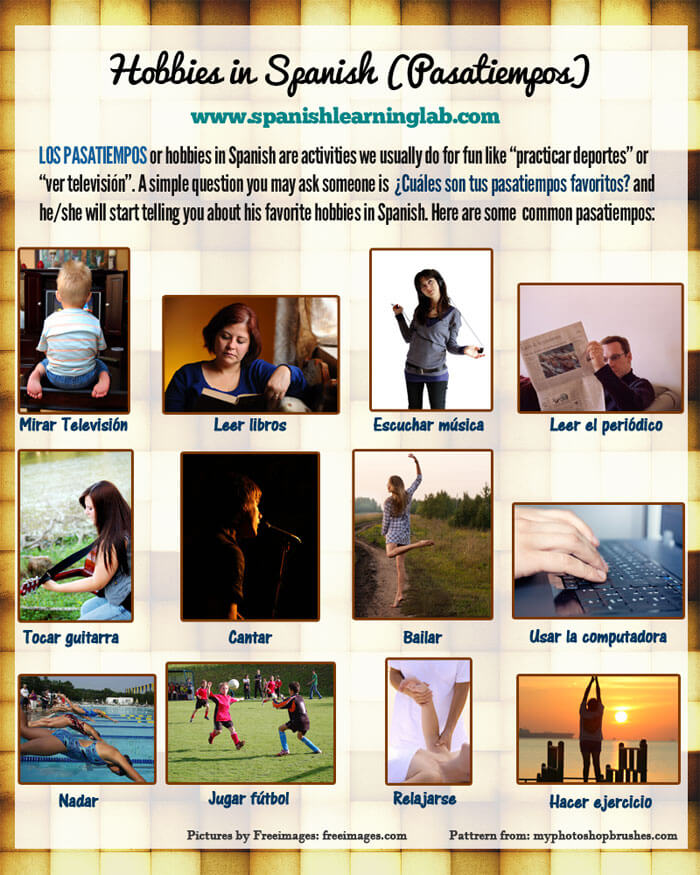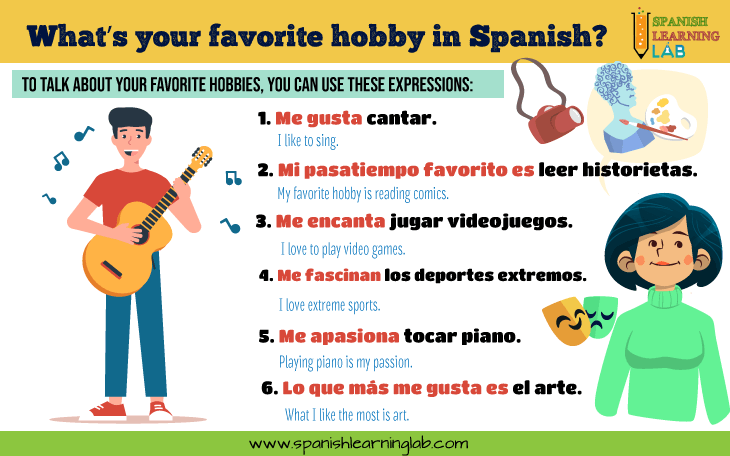¿Qué haces en tu tiempo libre? There are some many activities we can do in our free time or “tiempo libre”. In this lesson, we will cover a comprehensible vocabulary list of common free time activities in Spanish. This lesson includes beautiful illustrations, many audio examples and several interactive quizzes to practice everything about “los pasatiempos“. Let’s start…
Vocabulary Introduction: Common free time activities in Spanish
The expression “Las actividades de tiempo libre” is used to refer to free time activities in Spanish. Another way is using the words PASATIEMPOS and AFICIONES. As you may already know, Spanish verbs represent actions that affect something or someone and hobbies are indeed activities represented by verbs in Spanish, most of the time in infinitive (ending in –AR, -ER, -IR). Imagine you want to say something like “I love singing”. Your first idea might be “Yo amo cantando”, but this is not a correct way to say it. Instead you should say “Yo amo cantar” or in a more natural way: “Me encanta cantar”, with the activity being represented by a verb in infinitive.
When talking about free time activities in Spanish, we will conjugate the first verb and keep the second in infinitive. The picture below shows some photographs of people doing their favorite leisure activities or hobbies in Spanish.

Interactive quiz No. 1
Drag and drop the names of these leisure activities in Spanish under the correct pictures.
Making sentences about free time activities in Spanish
First, we will learn how to make basic sentences with free time activities in Spanish. Since these activities are verbs, all we need is to use one of the easiest grammatical structure for sentences in Spanish:
Subject or subject pronoun + conjugated verb (hobby) + complement (time or place)
For this type of sentences, it is not necessary to add a complement every time. A short statement like “I SING” can be simply translated into “Yo canto” and that would be totally correct. Remember to use the right conjugation for each verb. Following this rule, you can make sentences with other free time activities in Spanish such as TOCAR GUITARRA in “Yo toco guitarra”, where the word GUITARRA represents the object of the verb TOCAR (the equivalent of PLAY for music instruments in Spanish).
You can complete a sentence with a time expression like EN LA MAÑANA, EN LA NOCHE or even saying with whom you do something as in CON MIS AMIGOS, CON MI FAMILIA and so on. The chart below has more examples following this pattern. Press play to listen to the audio examples.
Examples of sentences with free time activities in Spanish
|
TOCAR GUITARRA – Yo toco guitarra
I play guitar
|
|
CANTAR – Yo canto en el baño
I sing in the bathroom
|
|
MIRAR TELEVISIÓN – Yo miro televisión en la mañana
I watch television in the morning
|
|
ESCUCHAR MÚSICA – Yo escucho música en mi computadora.
I listen to music on my computer
|
Interactive quiz No. 2
Fill in the blanks with the correct activity in Spanish for each case.
What are your favorite hobbies in Spanish?
Asking about favorite hobbies in Spanish
In order to ask someone “what are your favorite hobbies” in Spanish, we can use the questions ¿Cuáles son tus pasatiempos? and ¿Cuáles son tus pasatiempos favoritos?. We can ask about their favorite free time activities in Spanish using ¿Qué te gusta hacer en tu tiempo libre? and ¿Cuáles son tus actividades de tiempo libre favoritas?. We will learn more about GUSTAR, likes and dislikes, in the next lesson. Sometimes people will simply say a list of hobbies instead of complete sentences as you can see in these examples:
|
¿Cuáles son tus pasatiempos? – Mis pasatiempos son tocar guitarra, cantar y usar la computadora.
What are you hobbies? – My hobbies are playing guitar, singing and using my computer
|
|
¿Cuáles son tus pasatiempos favoritos? – Mirar televisión, jugar fútbol, hacer ejercicio, relajarme…
What are you favorite hobbies? – Watch TV, play football and exercise
|
|
¿Qué te gusta hacer en tu tiempo libre? – Me gusta tomar fotos, leer el periódico, dibujar y pintar.
What do you like to do in your free time? – I like taking pictures, reading the newspaper, drawing and painting
|
Saying your favorite hobby in Spanish
You can also answer these questions using the structure below. In addition, the chart includes other common free time activities in Spanish:

|
LEER LIBROS – Mi pasatiempo favorito es leer libros
My favorite hobby is reading books
|
|
BAILAR – Mi pasatiempo favorito es bailar
My favorite hobby is dancing
|
| NADAR y HACER EJERCICIO– Mis pasatiempos favoritos son nadar y hacer ejercicio My favorite hobbies are swimming and exercising |
Interactive quiz No. 3
Fill in the blanks with the correct words about pastimes in Spanish or the right form of the verbs in parentheses.
Free time activities and Spanish frequency adverbs
Spanish frequency adverbs such as SIEMPRE (always), USUALMENTE, ALGUNAS VECES (sometimes), A VECES, NUNCA (never), CASI NUNCA (rarely) are used to say how regularly you do a free time activity in Spanish. SIEMPRE, CASI NUNCA, USALMENTE and NUNCA are often used after the subject of the sentence, so we would say CARLOS SIEMPRE…, YO NUNCA…, NOSOTROS USUALMENTE…. and so on. On the other hand, the Spanish frequency adverbs A VECES, A MENUDO and ALGUNAS VECES are mostly used after the object or verb like in the sentence ELLA SE EJERCITA A VECES. Here are more examples.
| Free time activities in Spanish + frequency adverbs |
|---|
|
ESCRIBIR – Yo escribo poesía a veces
Writing – I write poetry sometimes
|
|
COCINAR – Yo siempre cocino en mi tiempo libre
Cook – I always cook in my free time
|
|
DIBUJAR– Los niños usualmente dibujan en clases
Drawing – The kids usually draw in class
|
|
TOMAR FOTOS – Mi amigo toma fotos a menudo.
Take pictures – My friend often takes pictures
|
|
PINTAR – Tú nunca pintas paisajes
Paint – You never paint landscapes
|
|
IR – Yo voy al cine/voy a pasear/voy a fiestas a veces
Go – I go to the movies/go for a walk/go to parties sometimes
|
Listening activity: Talking about my pastimes in Spanish
Interactive quiz No. 5
Sports are very common hobbies too. Make sure to check our listening lesson on that topic to learn more vocabulary and listen to examples of conversations, and please remember to check the lesson about hobbies, likes and dislikes related to this one.
Related Spanish Worksheets:
- Common Hobbies in Spanish
- Pastimes, Likes & Dislikes in Spanish
- The Verb GUSTAR in Spanish (Chart + Sentences)
- Common Sports in Spanish (Vocabulary)
- My Favorite Hobbies in Spanish (Reading)
- Likes and Preferences in Spanish – Conversation cards
